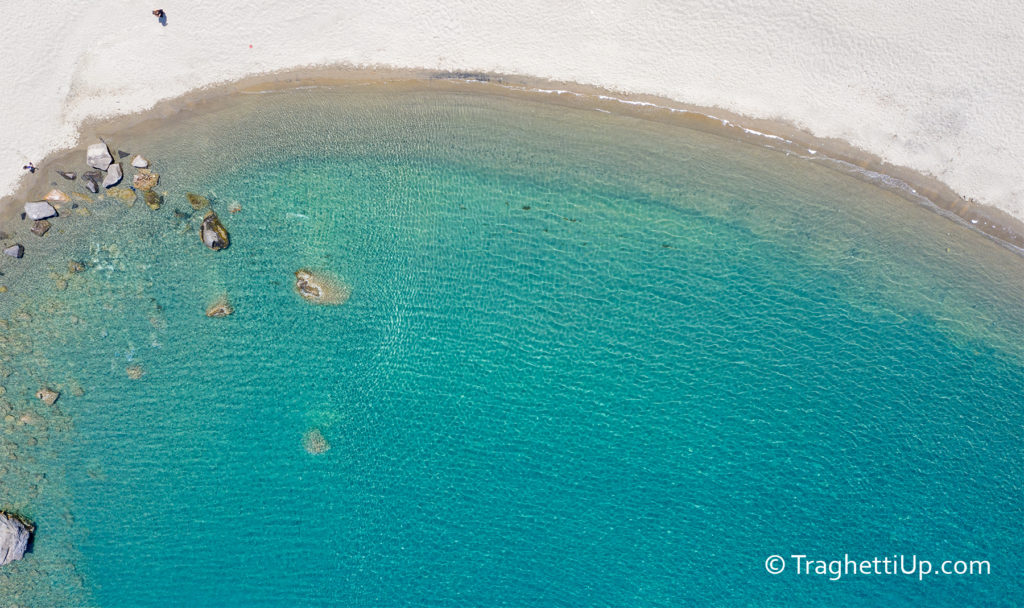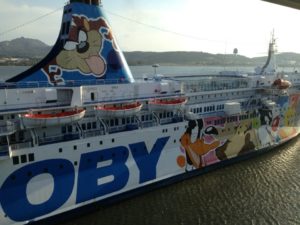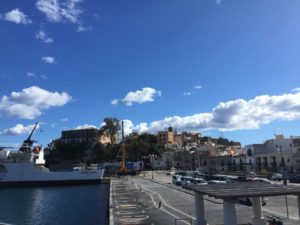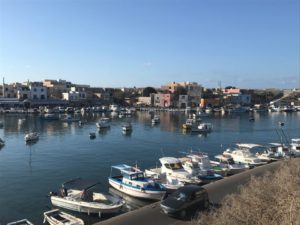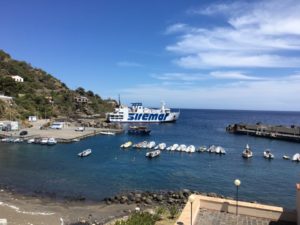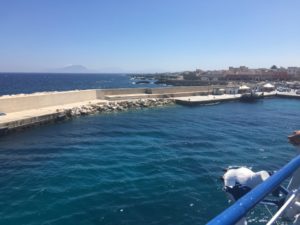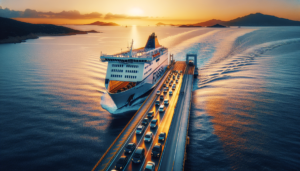Beaches in the town of Ischia
Sant’Alessandro beach
The so-called Spiaggia degli Inglesi or Sant’Alessandro, near the village of the same name, despite its small size, is almost never crowded due to its northern exposure which does not make it attractive to everyone, but also because it is not easily accessible; you must necessarily do it on foot: either along a side street of via Baldassarre Cossa, along the hill, or along a path of about one kilometer that connects it to the port. A nice stretch is free and once reached, it is ideal for relaxing. There is also a restaurant bar. In the morning it is shaded, the seabed is gravelly.
Pagoda beach
Without state concessions, the Pagoda Beach, although small, is totally free and is very popular by the inhabitants of the island. It is located outside the natural arm that forms the inlet of the volcanic lake that forms the port of Ischia, on the left side. Behind there is a public park with a pine forest. The name derives from the tower in typical Chinese architecture, now demolished, that Ferdinand of Bourbon had built.
Lido d’Ischia
In Ischia, the most central beach is the famous Lido, which runs parallel to the main town of the island. It begins east of Punta San Marco, the promontory that borders the port, with the beach of San Pietro, to get to the center, near the square of San Girolamo. It begins with some free stretches, then we find the equipped bathing establishments, often interspersed with small stretches of free beach (prices, depending on the time of the season, can generally vary between ten and forty euros). At this point the sand is interrupted by a cliff after which we find a last thin piece of beach before moving on to other establishments.
Punta Molino beach
After Punta Molino and the public gardens, on the seafront Cristoforo Colombo, there is another stretch of beach with equipped beaches and you are getting closer and closer to the historic place where in the 13th century was built the former Carcere Mandamentale.
Pescatori beach
In front of the heart of the seaside village of La Mandra there is the Pescatori Beach, both free and equipped, from which you may enjoy a breathtaking view with the Aragonese Castle, Vivara, Procida and, in the distance, the mainland.
Muro Rotto beach
The so-called beach of Siena or Muro Rotto is entirely free and spreads from the headquarters of the local taxi-boat cooperative for a long stretch, then is interrupted by the rocks and resume briefly just near the resort Lo Scuopolo, a small bay on which Palazzo Malcovati was built.
Cartaromana beach
On the eastern side of the town, there is, in the bay with the same name, the beach of Cartaromana, accessible by taxi-boat service or, not really comfortably, from San Michele, via a path and a hundred stairs. Small, with sand and gravel, with a free section and an equipped section, fascinating for the particular perspective view of the Castello Aragonese and for the proximity of the Sant’Anna rocks. Jets of thermal water emerge not far from the shore. The discovery of archaeological finds testifies to the settlement in the area of the ancient Romans.
Beaches in the town of Barano d’Ischia
San Pancrazio beach
Along the eastern side of the island in a southerly direction, after the Grotta del Mago, in the bay bordered by Punta Cannuccia and Punta San Pancrazio, we find the beach of San Pancrazio, accessible only from the sea but unfortunately currently closed due to the landslides that affected the overhanging ridge. However, the bay is accessible by boat, from where it is possible to enjoy the unspoiled nature and the crystal clear sea.
Scarrupata beach
Proceeding south, up to Capo Grosso, the coast is characterized by stones, with slopes almost always overlooking the sea, but there is a point where a steep path leads us to a pebble beach, with a restaurant that also has a sunbeds. Obviously the beach is also accessible from the sea and served by taxi-boats, both from Siena and certainly from the nearest Sant’Angelo. The beach of Scarrupata, or Sgarrupata, is a magical place, where silence reigns.
Maronti beach
Between Punta della Signora and S. Angelo there is the Maronti beach, the longest on the island,consisting of grains of medium-fine size. Along about three kilometers there are numerous equipped bathing establishments, as well as numerous free stretches. From via Provinciale Maronti you can easly reach a square overlooking the coast, where there are both paid parking and the bus terminal. If you want, you can then continue on foot, thanks to a walkway on the sand or by taxi-boat. Boat service is also available to and from the port of Sant’Angelo, with intermediate stops. At the eastern end the coast begins with a nice piece of free beach. The type of seabed is not particularly loved by families with small children, as the seabed is almost immediately deep. Continuing along the beach, after about eight hundred meters, you will notice the mouth of the Olmitello stream. Two hundred meters further on you can enter, from the beach itself between tuff walls, for a path that leads both to the renowned Terme of Cavascura and up above Serrara. Hotels, beaches, bars and restaurants that provide sunbeds and umbrellas continue to alternate with free stretches for a long time.
Beaches in the town of Serrara Fontana
Fumarole beach
Not far from Sant’Angelo, now in the town of Serrara Fontana, the Maronti are characterized by the Fumarole beach, where volcanic fumes emerge from the sand that are formed by the condensation of gas in contact with the air. Even in the sea you can see the effects of steam emission: in some places, the water heats up. The area is, at the right distance from the hottest points, particularly suitable for sandblasting. Before taking advantage of the therapeutic properties of thermal heat and mineral salts of the sand by submerging in it, it is however appropriate to consult a doctor even if it is a cure-all for arthrosis, rheumatism and other ailments but it is not recommended for anyone, such as heart patients, pregnant women or children. The high temperature is also often used for food: a restaurant uses it to prepare chicken, octopus, eggs and other dishes.
Sant’Angelo beach
Right near the famous square, the beach of Sant’Angelo is located on the opposite side of the port, from which it is separated by the canal that connects the Tower to the town. A small piece is free, while the remaining small part is served by three equipped bathing facilities. The bars that surround the pedestrian square are just a few meters away and at the end of the day the atmosphere becomes very refined without losing all the seafaring character that distinguishes the village. The landscape is characterized by the rocks called Le Parate, a peculiar rock formation of the islet on the side.
Cava Ruffano beach
The small beach of Cava Ruffano can be accessed by passing through the Lo Scoglio Restaurant above, which supplies a plot of land with sunbeds and umbrellas (another part is free), or through the Bar del Ponte. The location, below a ridge, does not make it sunny throughout the day.
Cava Grado beach
On one side of the S. Angelo bus terminal, there is a descent from which you reach a series of steps that will lead us to the small beach of Cava Grado. There is a restaurant bar and sun loungers, as well as a short free stretch.
Book a ferry
Beaches in the town of Forio
Sorgeto beach
Sorgeto is renowned and appreciated for the hot spring of thermal water enjoyable in the pools of rocks built into the sea. The restaurant of the place gives the possibility, as well as to refresh oneself, to lie down. The inlet is demarcated by Punta Chiarito, site of ancient human settlements. The return via land access is tiring due to the numerous stairs, but there is the alternative of the taxi-boat service.
Citara beach
Contained by Punta Imperatore, on the western side of the island, the beach of Citara is optimal for its accessibility/size ratio. In fact it is in front of the road and the bus stop. There are many guarded parking lots and it consists of an appreciable extension of fine sand. The western exposure allows you to sunbathe until late and admire spectacular sunsets. The gradualness of the depth from the shore is variable, as well as the seabed type. On one side of the coast stand out the famous spa gardens Poseidon thermal gardens. Many establishments, also equipped with catering services, provide umbrellas, sunbeds and sun loungers, but there is no shortage of freely usable spaces. The name derives from Citerea, appellation given to Aphrodite (goddess of love).
Cava dell’Isola beach
Starting from the Pietre Rosse the wild beach of Cava dell’Isola begins. In high season crowded with young people and beach sports practitioners – volleyball, football, Frisbee – as it is entirely free. The bathing equipment is not ready but can only be picked up at the two restaurant bars that are on the opposite side. The length is about three hundred meters and the width is often important in some areas. The depth of the seabed is not gradual and the sun becomes very powerful even due to the rock behind which reflects its rays. To access it there are stairs or a sloping path.
Spiaggia dell’Impiccato
Right in front of the homonymous rock, near the port of Forio, there is the very small beach of Impiccato. In dialect this rock in front of it is called “A pret ‘u’ mpis“, shaped by the waves that gave it a particular shape, having split it into two parts. We are next to the Levante pier that, on the occasion of the rare but intense storms with strong winds from the northern side, it is not sufficient to protect the port; evidence of this is the sinking of sixteen boats during the memorable storm of the first days of January 2010, when the wind gradually veered northwards reaching 90 km per hour and shaking considerably the sea (a breakwater structure was then built close to the this pier). On these occasions, changes in the geomorphological structure of the seabed were caused by the formation of steps that made the rock unstable, causing it to crack in half under its own weight. The crack that was created over time was then widened by winds and waves.
Chiaia beach
From Monticchio to the Rotonda, for about five hundred meters, there is Chiaia beach which has grain size not gravel but very fine. Thanks to the width, the bathing establishments equip several rows of umbrellas with sunbeds and also the free sections are very capacious. It is not difficult to get there, by both public and private transport, but also on foot, being not far from the historic center of the town. It is located precisely close to the provincial road 270 and then to Via Spinesante, all flat. If necessary. Large cliffs protect the coast from the waves. Very frequented by families with children, the sandy bottom is not deep near the shore and becomes so very gradually. Also thanks to the fine sand it is ideal for playing to build castels on the seashore.
San Francesco beach
About one kilometer from the center of Forio is the beach of San Francesco di Paola which winds up to the ridge of the Belvedere di Zaro where we can find a piece of free beach (there is also another on the opposite side). The rest of the coast, in concession to establishments, is equipped with the usual bathing equipment. The seabed does not always gradually decrease. The high-stars hotels and the pleasant walk make it more popular with lovers of greater refinement, which can often be found in the gastronomic offer even in the evening. The name comes from the adjoining church also known as the Sanctuary of the Madonna di Montevergine.
Beaches in the town of Lacco Ameno
San Montano beach
Set in the deep inlet between Punta Caruso and Monte Vico, the beach of San Montano is kissed by nature. The sand is fine and delicate, the flora makes the bay wild and hydrothermal resources are abundant, so much so that behind it rises the Negombo Thermal Park which, like another establishment, equips the beach. At both ends we find a free stretch and small rocks from which it is possible to get wet. The seabed is always sandy and does not degrade for several meters from the coast. The grain size is also great for children’s play of castle building. The north-western exposure does not make it overly sun-struck. A few minutes walk from the town center it also offers the possibility of secure parking.
Varulo beach
The Monache or Varulo beach is located lower than Punta di Monte Vico, inaccessible as it is in a cove that can only be reached by sea, but not accessible by boats as it is a protected marine area. The seabed is rich in aquatic plants (a real Posidonia prairie) and algae, of which are full the so-called “monache di mare” (in english “sea nuns”), a type of mollusc (technically Aplysia punctata) who appears to have a tunic.
Marina beach
The Marina di Lacco Ameno beach begins as a natural extension to the sea of Corso Angelo Rizzoli. The sand is fine and the seabed is sloping. The stretch overlooking the marina is about two hundred meters long.
Fungo Beach
By the pier that delimits the Porticciolo there is the little beach of the Fungo (in english “mushroom”), characterized by this nice tuff formation with the diameter of the “hat” measuring about twenty meters, not far from the shore.
Beach of the tourist port
After the pedestrian area, now on the coastal road, there is a small managed beach that follows the tourist port, recently restored through the technique of refilling.
Fundera beach
Right on one side of the island’s heliport, a little below street level (provincial 270), you can see the tiny beach of Fundera, from the name of the district. Here, too, the sandy grain size is fine, with a sloping seabed.
Beaches in the town of Casamicciola Terme
Casamicciola Marina beach
Just before the tourist port of Casamicciola Terme, the Marina beach is partly managed and partly free. It is not very extensive, with fine sand, with a gently sloping seabed. Not far from the end, raised platforms have been installed over the sea equipped with umbrellas, reclining beds and showers.
Convento beach
In front of the Church of San Gabriele we find this strip of beach, called “del Convento” for the monastery situated nearby the church. The beach is partly held by a licensed manager and it is very sheltered thanks to very close cliffs.

